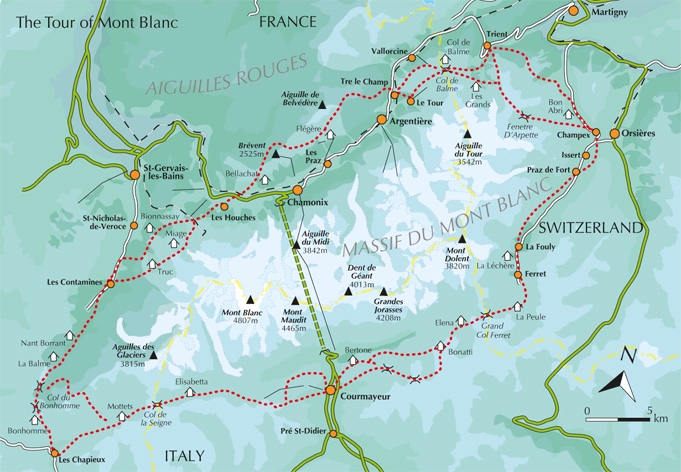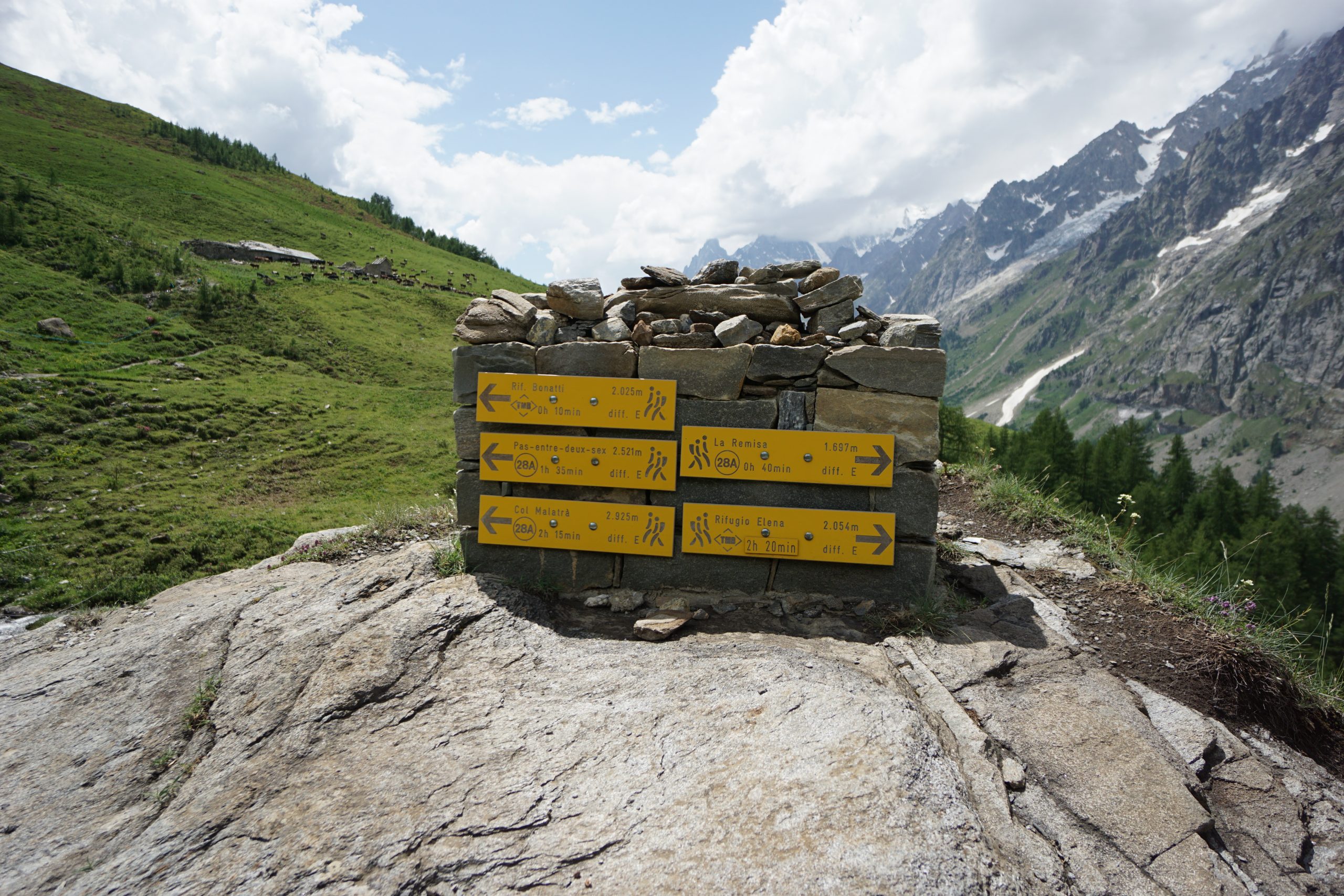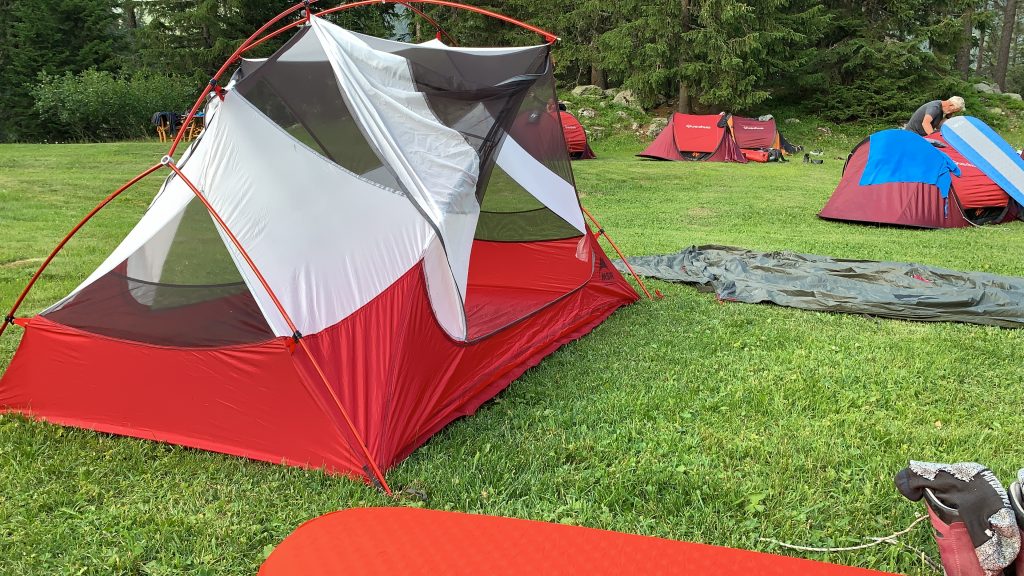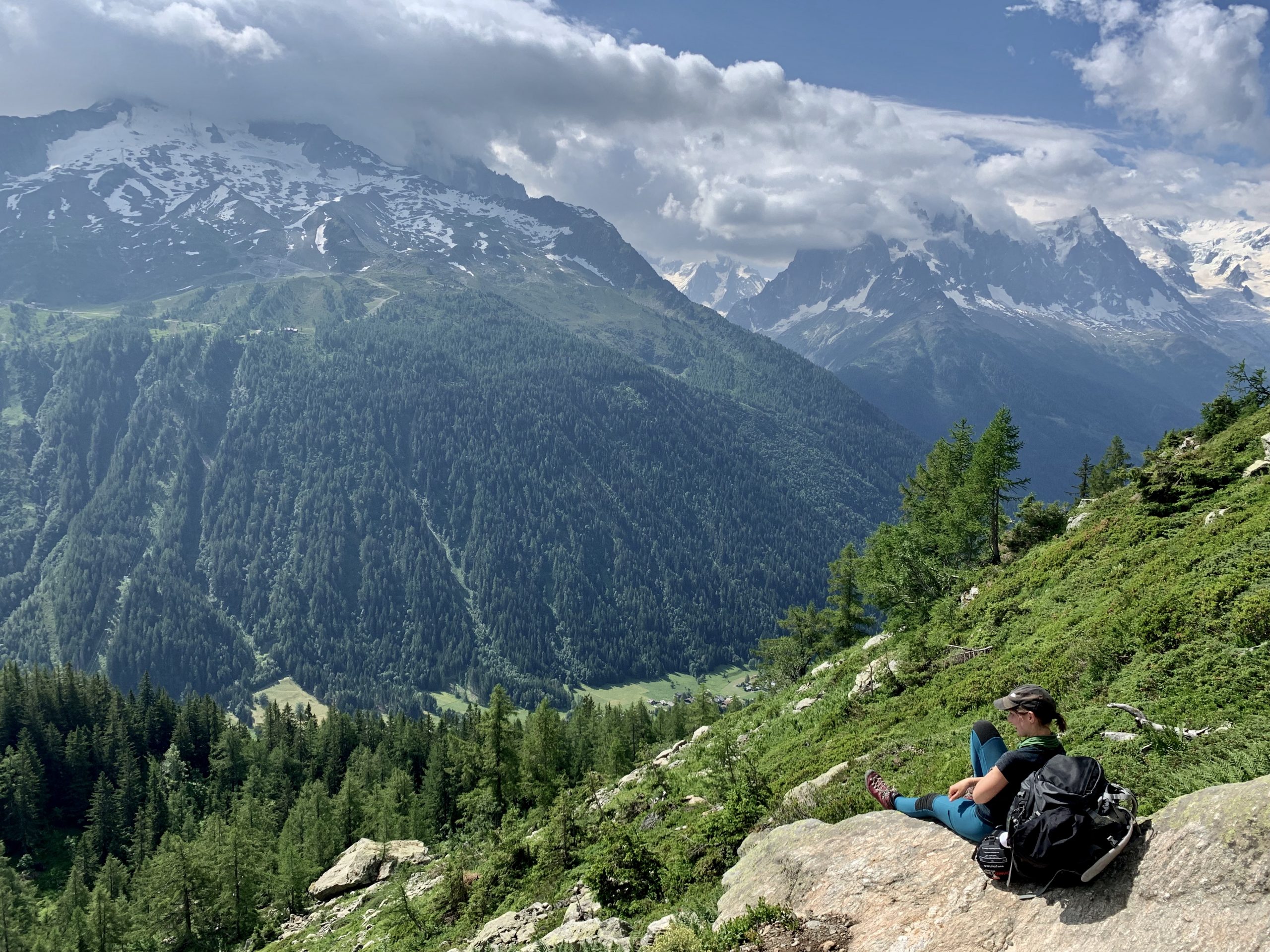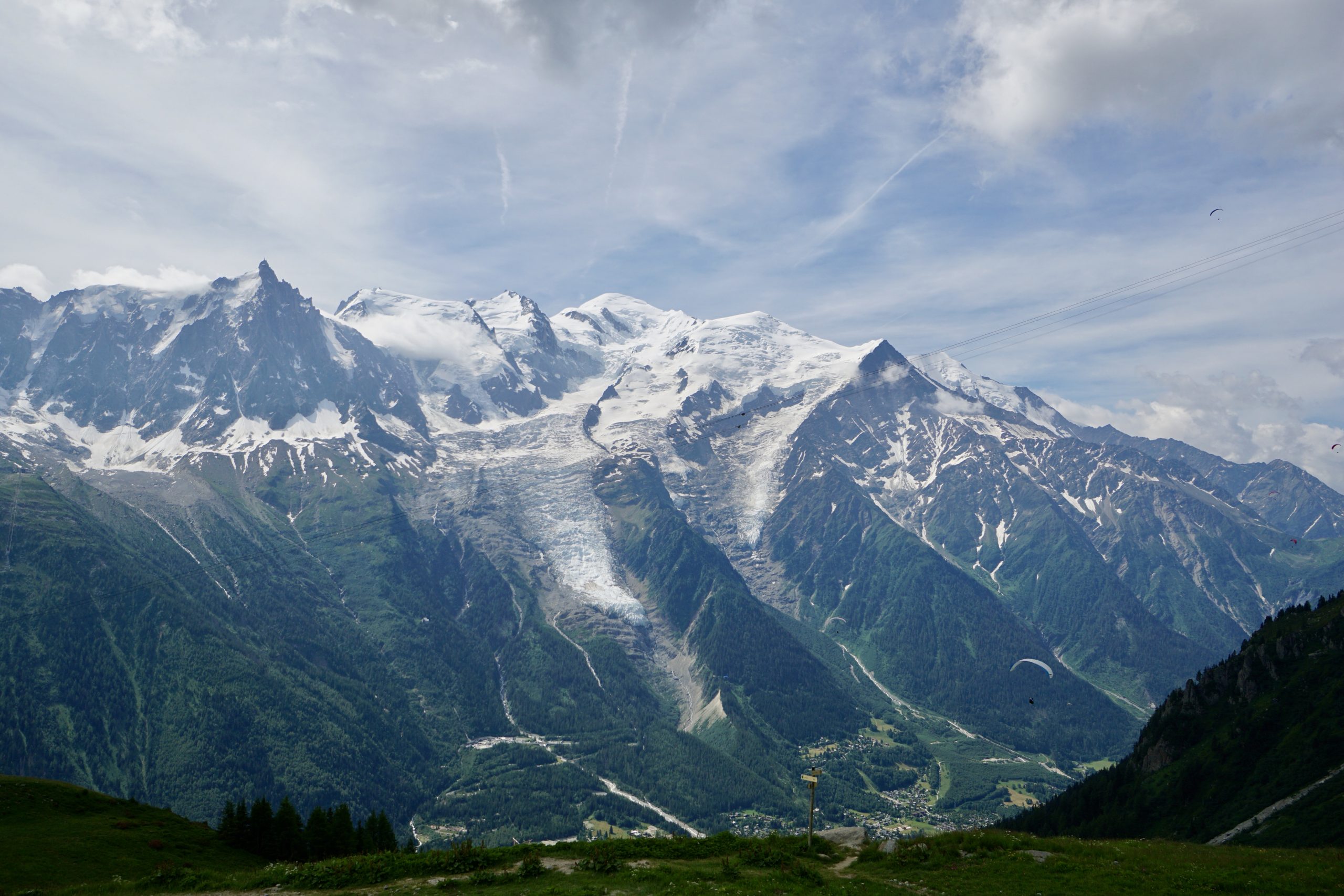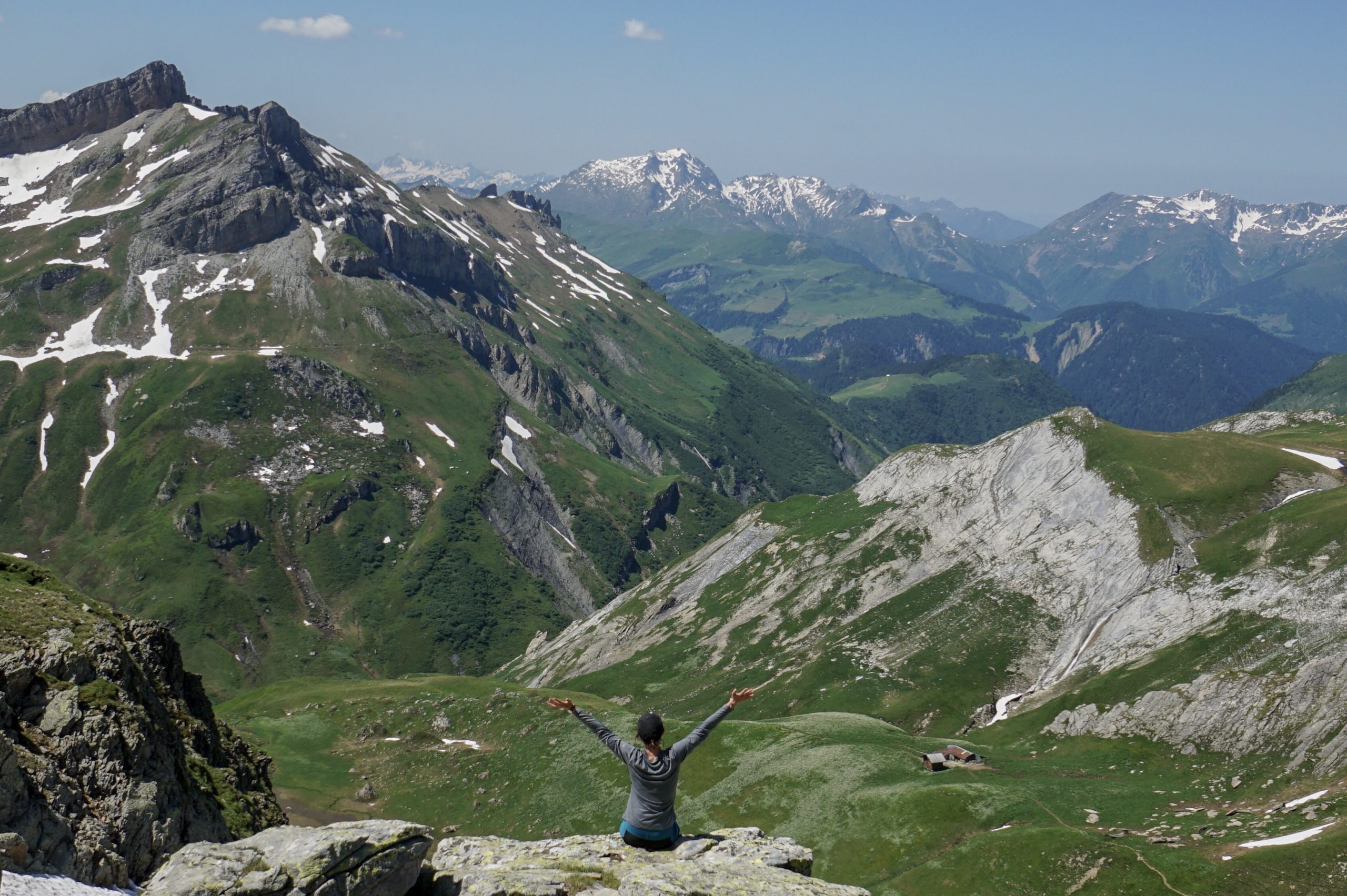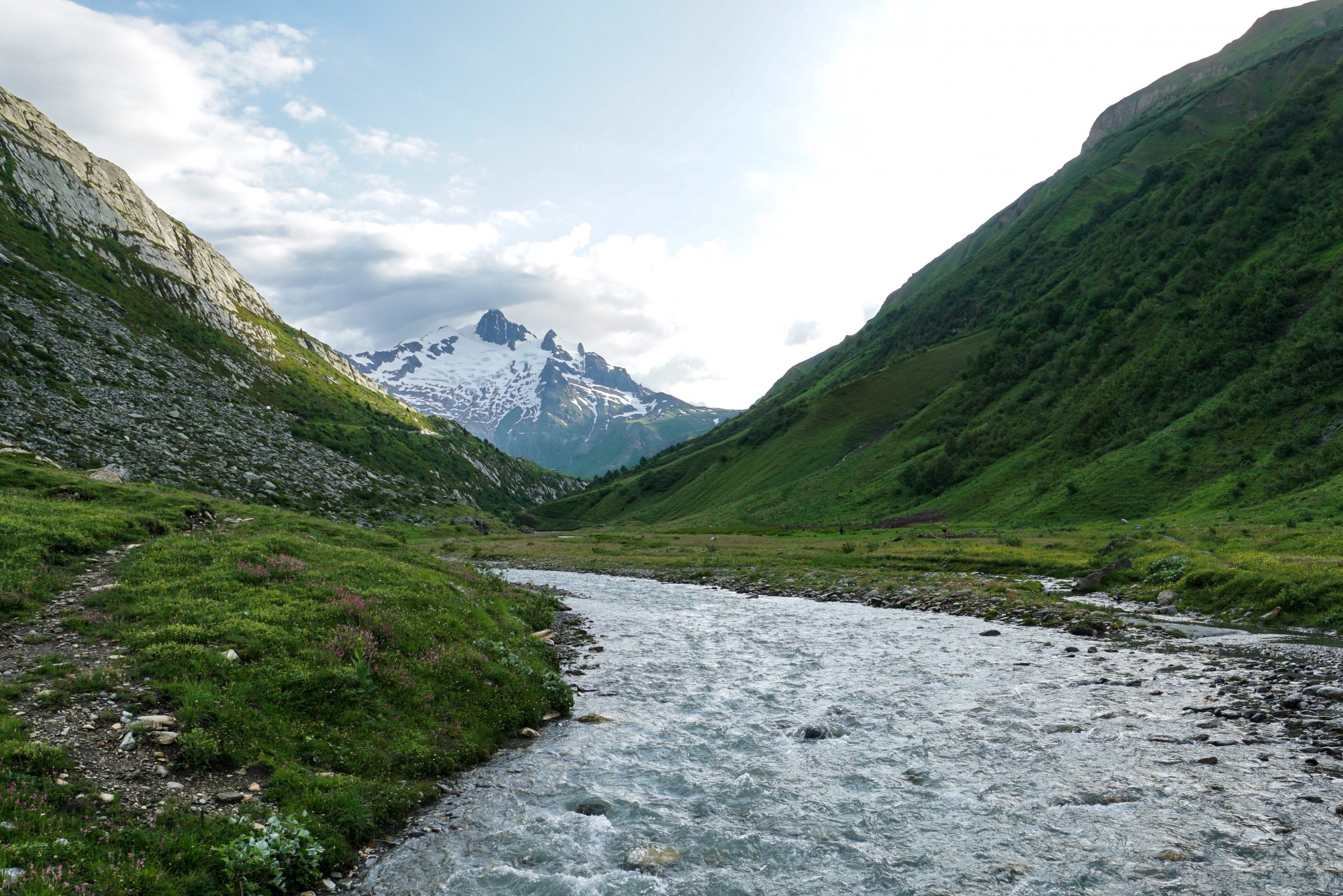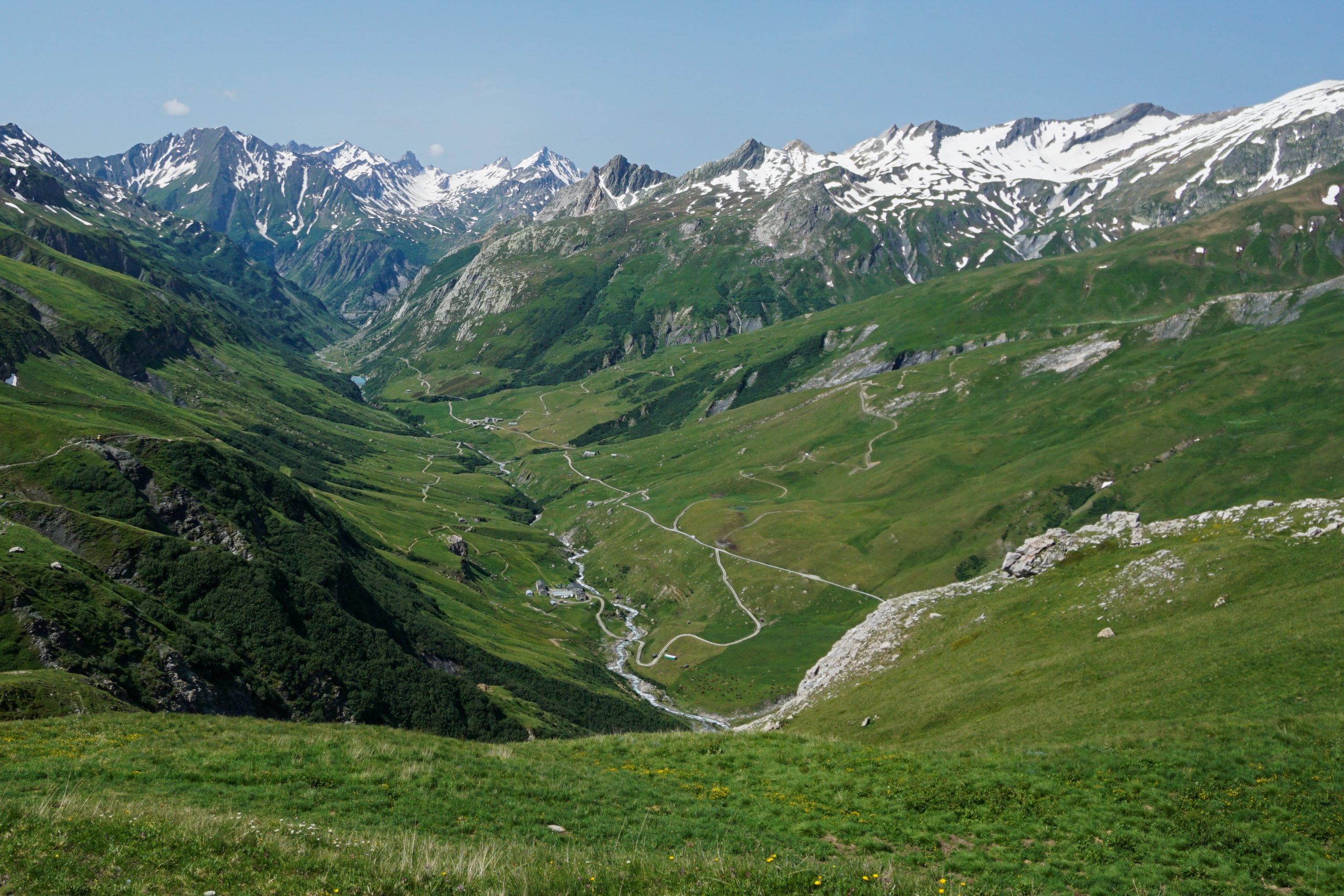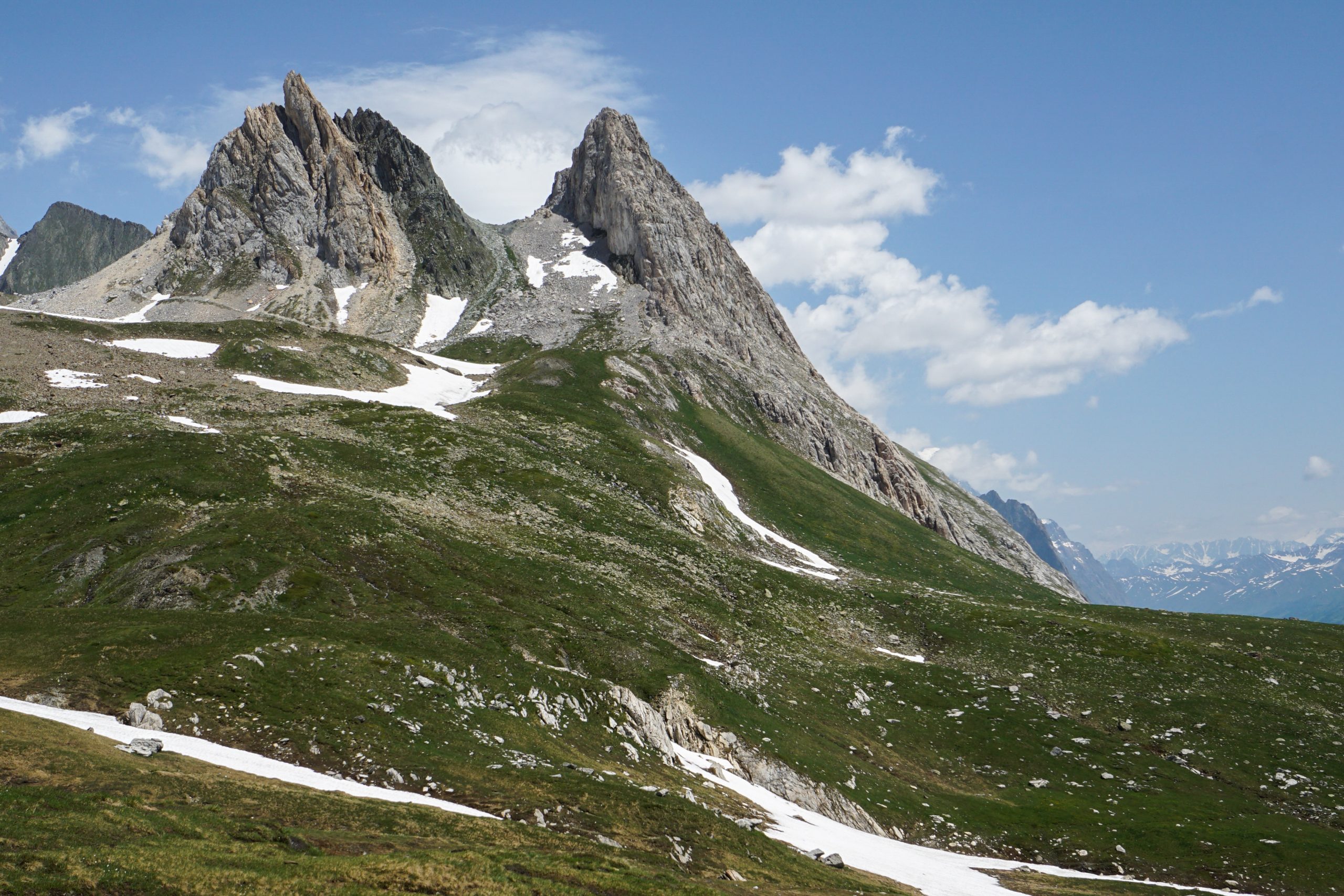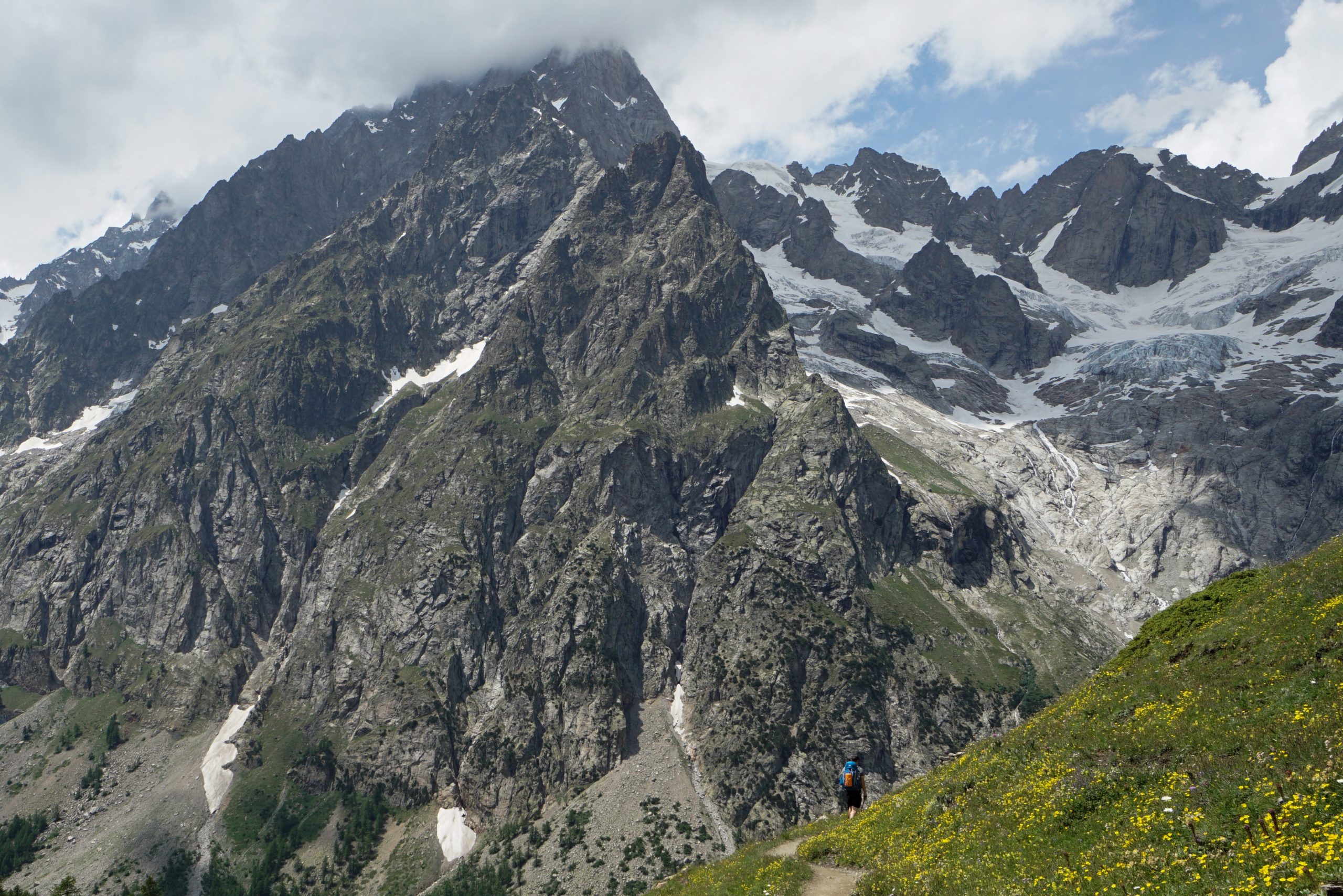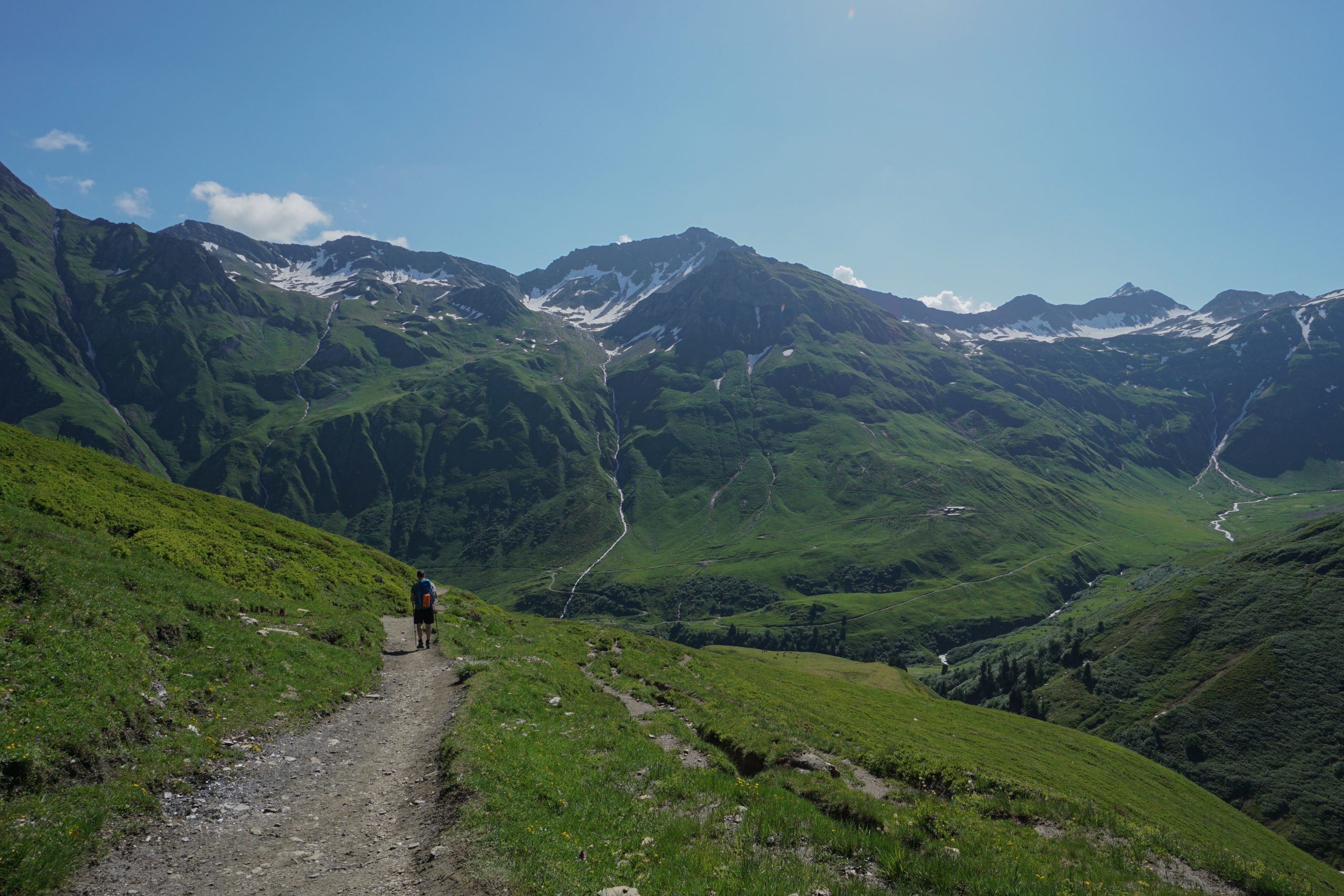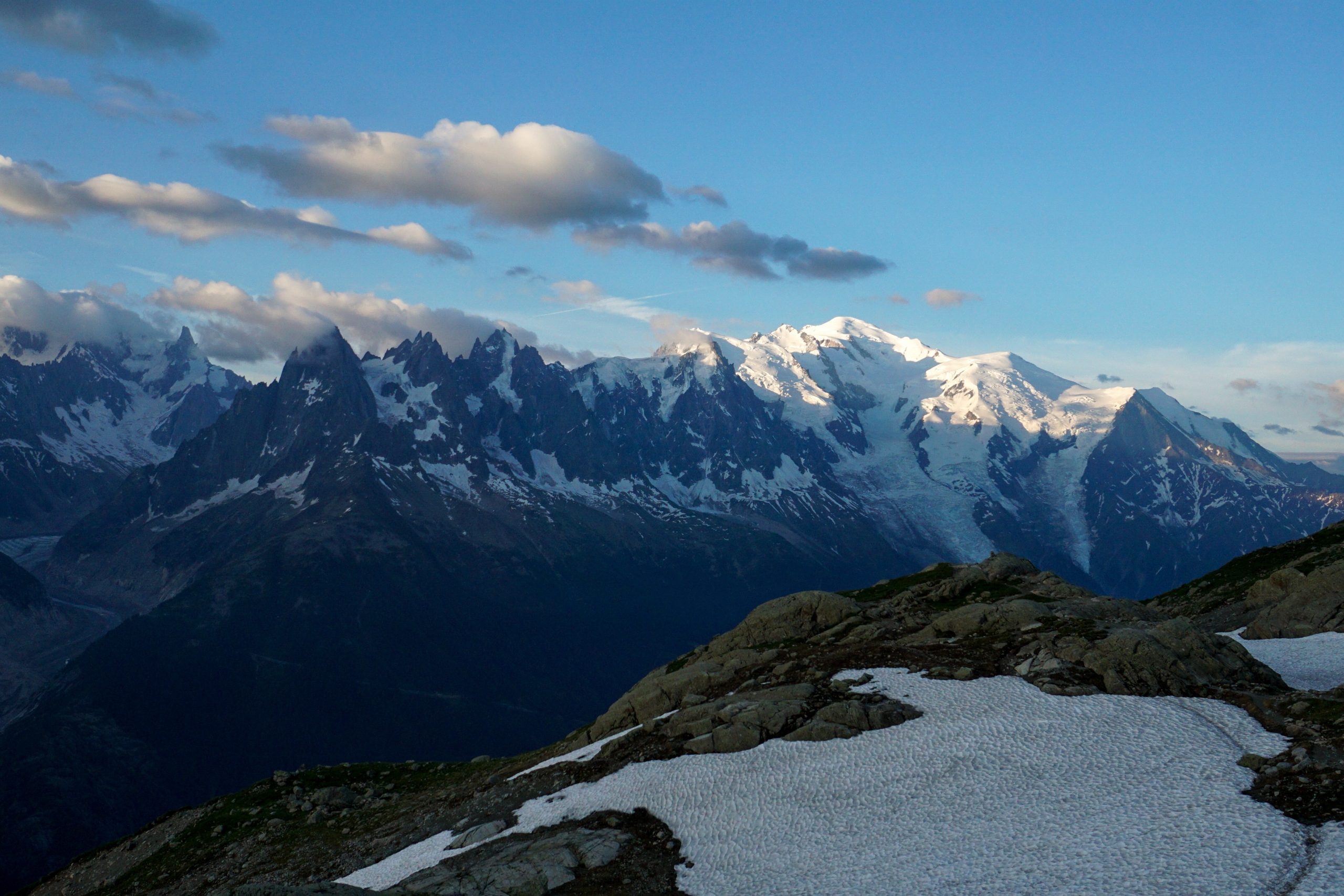Tour du Mont Blanc

About Tour du Mont Blanc: Also known as TMB it is a circular trek around Massif of iconic Mont Blanc taking you through three countries: France, Italy and Switzerland. Pretty nice, right? It was indeed a spectacular hike. I knew that Alps are beautiful, but did not expect to be THAT impressed. As TMB is one of the most famous treks in Europe, it attracts a lot of people every year. Empty trails is the least you can expect.
How long does it take? The duration really depends on your physical shape and trail choices, Usually it takes from 8 to 12 days, but I can imagine that ultra-fast hikers do it even faster. There’s even an annual TMB marathon, so you can run the trail if you’re into it.
Difficulty: Some stages are quite easy, while others feature elevation gains and losses of ~1500m. I met so many different people that it’s hard to say whether this hike is for you. Let me put it this way – you should be fairly fit to hike the whole trail on your own (if you do not hire a travel operator and carry all your stuff on your back). It isn’t easy due to elevation jumps, but it is not technical either. It’s “simply” a StairMaster for 6 – 8 hours a day
Independent or via tour operator? There are plenty of operators who would arrange accommodation and luggage transfers for you if you’re willing to pay. In that case you’ll just carry a day pack and focus on making to the destination, no other arrangements needed. We hiked independently, so did all logistical preparations upfront by ourselves and saved quite some money on that. There’s a lot of information online, so this trek is perfectly doable on your own. The information I’m sharing is also for those who wish to self-organize such a trip.
Itinerary
How to get to the start. The official trail start is in Les Houches, France, where you can find a stand, indicating the start (and where to take the pictures) of the trail. However, it doesn’t mean that that’s the only start. A good thing about circular trails is that wherever you start, you’ll come back to the same place anyway, so in TMB you are free to start in other places than Les Houches. Cormayeur (Italy) or Champex (Switzerland) are also convenient starting points. Once you start planning, you’ll see that some flexibility is needed when arranging accommodations, so that might be the deciding factor for your start point.
We drove to Les Houches by car, which we could leave in a designated free (!!!) parking lot, called Prarion car park. Make sure you arrive there early as the park tends to get full fast.
If you can only come by plane, Geneva airport is the closest and most convenient. From there you can take a shuttle bus directly to Les Houches, which should take under 2h. Otherwise it is also possible to take a train, though it’s not direct and takes at least 2,5h.
We followed the anti-clockwise itinerary outlined in Cicerone guidebook, which is an excellent guide to this trip. We combined a few stages (the original trek takes 11 days) and took a few alternative routes, but nothing outside the book. Most of the days we’d spend hiking around 7-8 hours, including lunch and chill breaks, so combining some stages is definitely doable if you have prior hiking experience.
Why diverting from the original itinerary:
- Limited accommodation options and high demand. When we started planning this awesome trip (early April), we could only get 1 (I know!) refuge, which made us change our plans, get a tent and plan the itinerary where we can camp. Wild camping was not really an option for us yet as we had very little camping experience before this trip and hesitated to go “all in” camping. We decided to stay in designated campgrounds which were quite scarce on TMB, leaving us very little choice in terms of where to sleep.
- Time limit and physical condition. We learned from other blogs that it is quite popular to combine a few stages and so if you’re fit, you can shorten the whole trip. I agree with that. While being quite fit hikers, we found it completely doable to combine a few stages. It is perfectly fine to follow the original itinerary if you have time and luck with locations. That way you’ll have free afternoons to chill in the refuge or do more alternative hikes.
Clockwise or anti-clockwise? While preparing myself for this trip I read a lot of debates of which direction to take: to be clockwise or not to be? We chose the anti-clockwise direction basically because our accommodation arrangements dictated so. One thing is clear though – you’ll have great time both ways. A year after TMB we hiked a few sections clockwise and it was a great experience as well. If you have all the flexibility (given the accommodation), then pick the direction based on what places you want to visit as there are a few differences in the routes due to different elevation gains/losses.
Sections not to miss:
Day Start Finish Duration (h:mm) Distance Elevation gain/loss Accommodation
1 Les Houches Les Contamines 9:30 18km 1480m/1320m Hôtel Le Christiania
2 Les Contamines Les Chapieux 9:00 18km 1320m/930m Camping field in Les Chapieux
3 Les Chapieux Aiguille-Noire/Courmayeur 8:30 25km 1450m/1500m Camping Aiguille-Noire
4 Aiguille-Noire/Courmayeur Rifugio Elena 9:00 20km 1300m/520m Rifugio Elena
5 Rifugio Elena (+bus) Relais d’Arpette 10:00 25km 740m/1450m Camping at Relais d’Arpette
6 Relais d’Arpette Col de la Forclaz 6:30 18km 740m/830m Camping at Col de la Forclaz
7 Col de la Forclaz Tre-le-Champ 8:00 18km 870m/980m Auberge la Boerne
8 Tre-le-Champ Refuge du Lac Blanc 4:00 5km 990m/40m Refuge du Lac Blanc
9 Refuge du Lac Blanc Les Houches 10:00 20km 860m/2200m RockyPop Hotel
- Les Houches – Refuge de Miage – Les Contamines (Alternative Stage 1)
- Les Contamines – Col de la Croix du Bonhomme – Les Chapieux (Stage 2)
- Les Chapieux – Rifugio Elisabetta (Stage 3)
- Cormayeur – Rifugio Bonatti – Grand Col Ferret (Stage 5 & partly Stage 6)
- Champex – Fenetre d’Arpette – Col de la Forclaz (Alternative stage 8) – we hiked it during Walker’s Haute route, check out my journal for that day
- Tre-le-Champ – Refuge Lac Blanc – Le Brevent (Stage 10 & partly Stage 11)
Accommodation
Accommodation overview. We combined different types of accommodation: camping, mountain cabins (refuges/cabanes) and hotels. Our initial idea was to hike from hut to hut, but soon the reality kicked in as we could only book 1 (yes, uno) refuge. The rest were already fully booked. Remember I mentioned it’s a popular hike? That’s what happens when there are way more hikers than a mountain accommodation can handle. Without a fully secured sleeping arrangements we decided to expand our choices (and the weight of our bags) with camping.
While planning this trip I read that one can also just show up at the hut in the afternoon and if there’s a cancelation, you might get a place. We got one additional hut in this way. We also managed to secure another hut by just calling a day upfront. This is a risky approach though as we also saw people being denied a place in a hut, because it was full. It’s really up to you with what you feel comfortable. We didn’t want to risk ending up without any shelter, so we brought one with us.
If you are really not into camping, make sure to book mountain cabins in advance (at least a few months ahead). I used the official TMB website to check the availabilities. Bless that website, saved so much time!
Detailed review of each place we stayed
Below you can find an overview of each place where we stayed: overall impression, facilities, food, staff and price. Where possible, I added links to their websites (click on the name of a place). All prices are from 2019.
Overall impression: It was so great to lie in a bed after a gruelling first day. Our backs really appreciated it. Another reason why we enjoyed this place is a huge storm at night. We were glad to be inside.
Facilities: The room has a small bathroom with toilet and shower and even a table with two chairs to hang your (already) smelly clothes.
Food: We did not eat in the hotel.
Staff: We only met the hostess to check in and she was friendly 🙂
Price: 105 Eur + 1.8 Eur city tax
Free camping field
Overall impression: This was a free camping place, a spacious field behind the hamlet, so you will find a spot anytime you arrive. It is an exposed field at the bottom of the valley, so if there is a storm coming, you might want to stay closer to the Auberge, where buildings nearby might provide a shelter. We had a horrible storm raging in the valley when we stayed there and we were kind of in the middle of a flat field, which “added” to the experience.
Facilities: There is a free public toilet with a sink.
Food: In the hamlet, there is a very basic grocery store, where you can also order fresh bread for the morning. We got a spot for a dinner in the nearby Auberge de la Nova. It was our first Alpine hut dinner experience and I loved it. Long tables full of people, plenty of hearty food and hiking stories, we really enjoyed our evening there.
Staff: None
Price: Free!
Overall impression: It is a well-established campsite with little chalets and equipped tents for rent. Although the campsite is quite big, it is not noisy (or we were lucky). We had a spot between trees, so we got a much better cover from yet another storm. The next day we took a bus to Cormayeur, the bus stop is just outside the campsite, very convenient. As there are no camping places in Cormayeur itself, this place is a great alternative.
Facilities: They have everything you might need: showers, bathrooms, a restaurant, grocery store, even an ATM. Showers operate based on coin system, so you need to pay extra. It has warm water though and runs long enough to refresh after a long day of hiking.
Food: We had pizzas in their restaurant and it was really delicious. A true Italian pizza, awesome.
Staff: The staff is very helpful and friendly.
Price: 6 Eur for a tent + 8 Eur per person
Overall impression: This refuge sits in a spectacular location – just opposite Glacier de Pre de Bar. It is a large refuge and we stayed in a room with at least 30 bunk beds. They also have double rooms, but these tend to get booked fast. Thanks to the earplugs I could rest quite well. It is not one of those laid back cozy mountain huts where you feel like home, it is a functional place for you to eat, rest and move on.
Facilities: There are shared showers and toilets for dormitory guests. The facilities are quite basic, but all works fine. We did not have to wait in long lines either.
Food: We had a half-board deal, so we got a three-course meal for dinner and a simple buffet type of breakfast.
Staff: As it is a huge refuge, the staff is focusing on managing everything swiftly. Don’t get me wrong, they are friendly, but they also make sure you are served/got your answer fast.
Price: 109,50 Eur for two people in a dormitory (half-board)
Overall impression: One of my favourite camping places. The campground is behind the refuge building in a spacious field. It doesn’t get super busy so everyone has enough space between tents. This also allows to scout for a suitable slope to pitch your house on and you don’t need to stress out about getting a spot if you arrive later.
Facilities: Clean showers and toilets are in the refuge building. In this area you can also find a few plugs to charge the electronics.
Food: Relais d’Arpette is known for its great kitchen and their restaurant gets fully booked quickly, so if you stay there, make sure to book dinner in advance. Sadly we didn’t book in advance, so we did not get to try their famous dinner.
Staff: The staff is helpful, just some of them struggle with English a bit, so knowledge of a few French words might come handy.
Price: 30 CHF for a tent and 2 people
Overall impression: We stayed at the back of a hotel building in a designated camping place. It is an unusual campsite as it consists of three or four levels, where tents are stacked in rows. It does get packed, so even if you arrive early, you might find yourself surrounded by various tents before the evening. I did enjoy staying there though, we arrived there early and could chill in the beautiful hotel area, surrounded by the mountains.
Facilities: There are designated toilet and shower facilities specifically for camping guests. Everything was clean, the only downside was the line for the shower. Opposite the hotel there is a very small grocery store, where we managed to get Nutella, jam and bread for the next day, nice!
Food: We ate in the restaurant of the hotel. This is the place where I tried rusti (traditional Swiss potato dish) for the first time and fell in love with it (potatoes, duh!). So the food was good, but quite expensive. We had a single late lunch/early dinner meal to save money.
Staff: Everyone is friendly and helpful.
Price: 22 CHF for a tent and 2 persons
Overall impression: This was hands down the cosiest place we stayed in. Initially we planned to camp in the premises of this Auberge, but stormy clouds and rambling thunder convinced us to try and get a space inside. We got the last place they had – an attic, which you can reach via a ladder. And we had this place all to ourselves! The whole Auberge was like a little Hobbiton with beds in various fun places. I really enjoyed staying there.
Facilities: There are shared showers and toilets for the guests, everything is clear.
Food: As we arrived a bit earlier, we had some celebratory drinks and could not resist to try their blueberry pie. It was soooo good. I also learned that it’s a traditional French pie. Very educative trip in terms of cuisine knowledge. For dinner we again had a half-board, it was a great outside feast with fellow hikers.
Staff: Everyone is very helpful and friendly. The staff created a relaxed mood in the hut, exactly what I was looking for.
Price: 106 Eur for two people, half-board
Overall impression: At 2352m, this was the highest and most spectacular place we stayed. The refuge sits next to Lac Blanc while also overseeing the whole Mont Blanc range – awesome views guaranteed. Even though we had a cloudy day, the whole area was just breath-taking, so I definitely recommend to at least take a hike past Lac Blanc. This refuge wasn’t in our original itinerary, we somehow decided to try our luck and inquire for a place a night before and got lucky.
Facilities: Due to the height, the facilities are quite limited. You need to pay for the shower and they don’t have potable water. You can buy 1,5l bottles for ~5 EUR (premium water!) if in need. We stayed in a dormitory room again, a bit smaller than in Rifugio Elena. Earplugs were essential again
Food: We had a half-board arrangement, classical hut food with soup, main dish and dessert.
Staff: People at the hut were friendly. If you want to reach them before visiting, best to call as there’s no reception in the hut.
Price: 60 Euros per person for a dormitory room (half-board)
Overall impression: This was our celebratory stay after finishing TMB. Very hip hotel with great atmosphere, we really enjoyed staying there.
Facilities: You can imagine that after more than a week of camping and staying in dormitory rooms, this was such a luxury – our own hotel room with own shower etc. I’ve spend probably 20 min just standing in the warm shower, washing away the dust and muscle pain accumulated in the past 9 days. There is even a sort of chill place in the premises where you can have drinks, eat our own food, play games and just chill 🙂
Food: The restaurant of the hotel was fully booked, but we managed to arrange a take-away. The food was really good, we enjoyed celebratory burgers and even got Magners ciders. Edo still remembers with envy those tasty burgers.
Staff: Everyone was super friendly and attentive.
Price: 89 Euros for a double room
Gear
Weight. My total base weight (everything inside my backpack, except water and food): 10kg. Before the start I was fairly happy with it, but then I added 2l of water and snacks… After the first day of hiking I couldn’t feel my back at the end of the day. It felt as if every single muscle was made of wood. Later my body got used to the weight, I also got more efficient with water (take how much you need until the next source), but I would definitely cut some weight next time just to have more comfort while walking.
Packing system. Another note is to pay attention to how you pack your items. I was a total newbie and did not balance the weight properly as I simply packed stuff based on how it fits instead of how it would be easier to carry. What’s more, I kept my sleeping back outside the backpack, which is risky if the weather turns sour + the weight balance is completely off. For your own comfort and for the sake of your gear don’t neglect this step and pack smart. There are tons of illustrations and videos on how to do it. Check out the backpack packing videos made by hikers I follow: Chase and Darwin.
Top 5 items, I appreciated during this hike:
- Hat – after years of irresponsible walking in the sun and getting headaches (duh) I now cannot imagine any hike without a hat. We had a lot of sun at high altitudes, so a head cover is a must.
- Hiking sticks – I bought Leki Cressida sticks for this trip and tried them once on a day hike in High Tatras in Slovakia. On that trip I wasn’t super convinced I need sticks, but boy I loved them on TMB. When you have crazy elevation changes and +10kg backpack, you will appreciate that extra support the sticks give. They are also super handy if you need to hike through snow. First day you might be getting used to them, later you will never want to let them go.
- Earplugs – we stayed in dormitory rooms only twice, but both times there was someone snoring in the room (there is always a snorer. Always.) and I really appreciated having earplugs. Mine where from Alpine hearing protection.
- Tent – this was our first trip with this tent (MSR Hubba Hubba NX) and it definitely proved to be a one solid house. It is a strong tent (survived a crazy storm), easy to set up and weights under 2kg while being rather spacious. We could put our backpacks inside and had a small “hallway” for hiking sticks and shoes.
- Camera clip – I had Peak Design Capture Camera V3 and it works just great. You can easily get the camera anytime you want and it sits securely on your shoulder. Of course, it shouldn’t be a very heavy camera. Mine was Sony a6000 + 10-18mm Sony wide lens, so around 700g.
3 items I would not take if I did the same trip again:
- Rain pants – I don’t think I used them at all. It was a great weather most of the hike, storms would come in the afternoon when we are sheltered somewhere. Even if it rained while hiking, I didn’t have time (or willingness) to put them on and getting my legs wet was not so bad.
- Backpack – I would take another backpack next time. Mine was Osprey Stratos 50l with dozens of bells and whistles that all just add up in weight. It is a bit bulky and tends to get wider the more stuff you add so weight balance didn’t work for me that well. I would get a bit smaller and lighter backpack for better ergonomics and comfort.
- That extra shirt I never wore – if you go for a few day hike, you soon realise that you can (and you will) wear the same clothes for a few days. After a few days you will just wash them in one of the villages on the way. If you have one long sleeve shirt, don’t take a second.
Daily journal
So how was it? I wrote my experiences and adventures in the daily journal below. For each day you’ll find not only my stories, but also more pictures and practical tips for that particular stage. If you still miss any information, feel free to post your question(s) in the comment section (at the bottom of each daily journal) or contact me via a contact form.
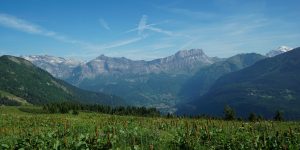
Day 1: A better alternative & my poor back
Here we go! It’s 6:30 AM and we are ready to kick off the TMB, which officially starts in the centre of Les Houches (yes, it actually has a starting point).
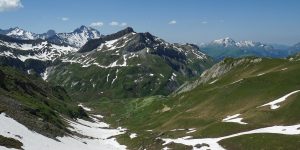
Day 2: It's so beautiful here & hold the tent!
This was one of my favourite sections of the whole hike. Our backs recovered from yesterday and we were ready to conquer the trail again.
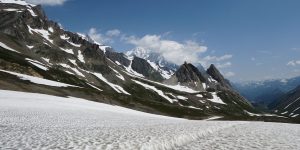
Day 3: Best food on the trail
The morning started on a fun note with hikers sharing survival experiences with the fellow “lucky” ones camping. We did not sleep a lot but could not linger.
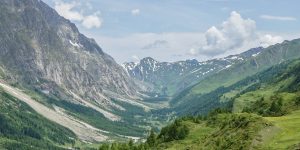
Day 4: Our first stay in a rifugio
From Rifugio Bertone there is an option to take a higher variante path and I’ve heard it’s very beautiful. We debated for quite a while whether we should do it.
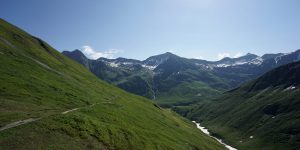
Day 5: Getting lost once in a while
Today is the last day of combining two stages and so the last relatively long day. We said goodbye to the spectacular views at Rifugio Elena and moved on.
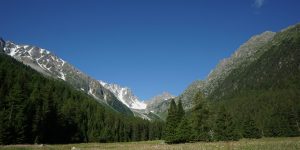
Day 6: Very modest corner of Switzerland
I think TMB only grazes Switzerland without showing a lot of dramatic landscapes this country is known for. The previous stages spoiled me.
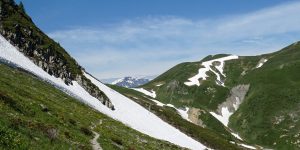
Day 7: Take the alternative and the terror hill
Today we decided to take the alternative route via Refuge Les Grands as it seemed to be more scenic and less crowded. It turned out to be absolutely true.

Day 8: The highest refuge on the trail
This section is rather challenging due to steep ascents AND ladders. For those scared of heights – as long as you don’t look down, it’s all fine.
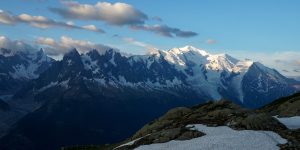
Day 9: Never ending descents
Our final day! Mixed feelings as the prospect of ditching the backpack and sleeping in a nice comfy bed was very tempting, but I also started already missing the views.
